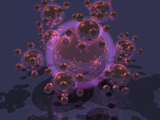Ray Tracing
PLEASE NOTE: THIS PAGE HAS MOVED

Blessed State, by
Ken Musgrave, is one of my favourite ray-traced images.

Glowflake, by Dan Farmer, one of the many demo files from POV-Ray 3.0. Based on Eric Haines' Sphereflake.
Unfortunately, neither of the above images are my creations, in case you
are wondering. However, this is the logo I created for our parent
research organization, the Canadian
Networks of Centres of Excellence. Not quite in the same league
artistically, but I like it none-the-less. Needless to say, the
source file took a lot of mucking with trig stuff,
which would have been trivial with POV 3.0.

An interest that I picked up in my undergrad days when I wrote a ray-tracer
of my own, as part of a fourth-year project, ray-tracing has since been a
hobby of mine. Although I haven't been spending any time rendering lately,
I have worked on some things that I hope will be useful:
- I am no longer official maintainer of the Raytracing FAQ.
The new maintainer is
Markus Kniebes <m.kniebes at cyrus.ruhr.de>
and the latest version is available at
his site.
- I'm an ex-POV-Ray Team Member, formerly in charge
of the Unix development and distribution, including the release of the
Linux and SunOS binary packages. The POV 3.0 Unix distributions are
considerably more Unix-like, thanks to a man page, a ".povrayrc" config file,
good X Windows preview display, signal handling, and more.
- I have invested some time into PVM POV-Ray
in order to learn about PVM (Parallel Virtual Machine). A patch is available
for POV-Ray 3.0 to allow rendering an image/animation on a network of computers.
- I have written jpegpov, a patch so
POV-Ray 2.2 can read and write JPEG files directly.
- A gamma test image, created by the
PNG development group,
is available online with some instructions on how to find out your
system's overall display gamma.
- I thought it would be cool if POV-Ray had support to read zipped and/or
gzipped files directly, to save on disk space for those large triangle mesh
objects, and other large include files. It could all work transparently
to the user, and POV-Ray would be able to detect if the input file is
compressed, so there shouldn't be any compatibility problems. For UNIX
systems, it could just be a pipe to open gunzip to decompress the file, but
since the advent of the
zlib
package, it may be the same patch on those poor platforms that can't
multitask. Since PNG uses zlib, this addition shouldn't add too much
overhead if you are already using the PNG patch, or POV 3.0 which already
uses zlib for the PNG support.
- Another interesting, yet hopefully simple feature that I think
should be added to POV-Ray is having it add comments to the output files
with info like the author, system, POV version, rendering time,
viewpoint, etc, so that at a later date, this info will be available.
Sure this can all be added by hand, but then again, you could always
create pictures using MS-paint too :-). The PNG patch currently
supports automatic comments, and since I wrote the JPEG patch, it may
eventually support comments as well. Most output formats support
comments, so it shouldn't be too hard to do. If you compile your own
version of POV-Ray 3.0, you can enable comments in PNG and PPM output
by adding a "#define POV_COMMENTS" in your config.h file.
If you are just interested in ray-tracing, or would like to generate a few
sample images on your computer, but don't want to compile it yourself,
executables are available for most systems. These come in two flavours:
Official executables
for DOS, Mac, Windows, Linux, SunOS, and Amiga, and
unofficial
executables which are for most UNIX systems, or have been modified by
someone not on the POV Team either to improve performance on a specific
platform, or to add new features.
You can find lots of utilities to aid in
generating ray-traced pictures and animations at the
POV-Ray home site.
This site also has many great
ray-traced pictures, to give you an idea of what can be done with this
powerful, yet totally free package. You should also have a look at the
POV-Ray CDROM, which is
available on-line.
You are visitor No:
78,228
<adilger at shaw dot ca>
 Back to Andreas' home page
Back to Andreas' home page


